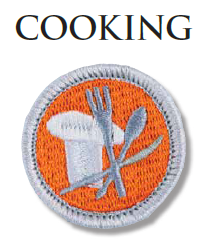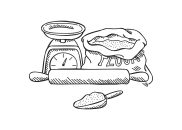Cooking Merit Badge Health & Safety
[text-box width=”100%” align=”center”]

[unordered title=”Areas of Study:”] [line]Health and Safety[/line] [line]Nutrition[/line] [line]Cooking Basics[/line] [line]Cooking at Home[/line] [line]Camp Cooking[/line] [line]Trail and Backpacking meals[/line] [line]Food related careers[/line] [/unordered] [/text-box] [div-line] [text-box]
Food Allergies, Intolerances and Sensitivities
A food allergy results when the immune system mistakenly targets a harmless food protein – an allergen – as a threat and attacks it. An allergic reaction may include rashes, hives, itching, swelling to severe trouble breathing, wheezing, loss of consciousness and even be life threatening.
Food intolerances and sensitivities are less threatening, but still a concern when cooking for other people. Usually people will take Benadryl or other allergy pill to take care of the symptoms.
Knowing who has what food allergies is the #1 step to avoiding any allergic reaction.
Everyone needs to have some idea of a “Food allergy action plan”. These can include having what is called an “Epi Pen” or other medication available. This reverses the effects of anaphylactic shock which is one of the reactions to food allergies (moderate to life threatening).
While any food can cause an allergic reaction in the US there are only 8 foods that account for 90% of all food allergies: peanuts, tree nuts, milk, egg, wheat, soy, fish and shellfish.
Before any campout, be able to identify if any scout has a medical bracelet that shows high risk allergies such as food or medication. In some cases the camper may provide his own food for the camp. That is one way to avoid a food allergy reaction.
The more you know about food, the more you will be able to find substitutions in cooking to avoid allergic reactions. Some examples are instead of pineapples, serve apples; instead of nuts, use seeds; if someone is allergic to chicken then serve turkey.
Lactose intolerance people are not able to digest lactose which is a type of sugar found in dairy products. The symptoms of lactose intolerance are cramps, gas, bloating, and diarrhea within 30 minutes-2 hours after consuming dairy products.
Non-Celiac gluten sensitive people experience the same digestive symptoms as the next section (Celiac disease and gluten sensitivity). But they can also get headaches, joint pain, and numbness in the legs, arms and fingers. These can be very uncomfortable and can ruin the camping experience.
Celiac disease and gluten sensitivity –
Some people have negative reactions to gluten which is found in wheat, rye, barley, and maybe oats. Celiac disease can cause many symptoms including bloating, gas, diarrhea, constipation, headaches, itchy skin rash, and pale mouth sores. Different people have different symptoms.
People with celiac disease when they eat gluten, their immune system reaction may damage the lining of the small intestine, preventing proper absorption of the nutrients in the food. Over time, patients may become malnourished. Symptoms of those affected by non-celiac gluten sensitivity are similar to those who have the actual celiac disease; however, the same antibodies and intestinal damage as celiac disease do not accompany non-celiac gluten sensitivity. These 2 conditions are on the rise in America.
Diabetes –
Diabetes is the name given to disorders in which the body has trouble regulating its blood-glucose, or blood sugar levels. There are 2 major types of diabetes: type 1 and type 2.
Type 1 diabetes is an autoimmune disease in which a person’s pancreas stops producing insulin, a hormone that enables people to get energy from food. It strikes in childhood, adolescence, or young adulthood and lasts a lifetime.
People survive type 1 diabetes by taking multiple injections of insulin daily or continually infuse insulin through a pump.
Type 2 diabetes is a metabolic disorder where a person’s body still produces insulin but is unable to use it effectively. This usually comes in adulthood however with increased obesity rates, many children and young adults get type 2 diabetes. Taking insulin does not cure any type of diabetes. Generally it is said that much of Type 2 diabetes can go away with regular exercise, weight loss, and healthy food and drink consumption habits.
This disease devastating effects include inflammation, nerve damage to the feet or hands, kidney failure and blindness.
With awareness of food allergies, intolerances and related diseases, and adequate planning and preparation, it is possible for all Scouts to enjoy a safe and nutritious meal at home or at camp.
[/text-box]
[div-line]



